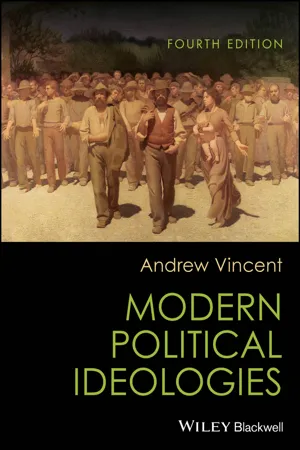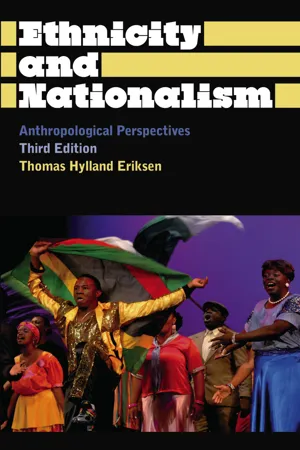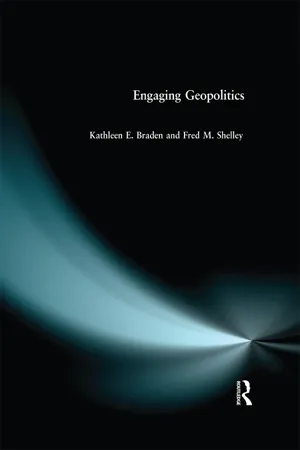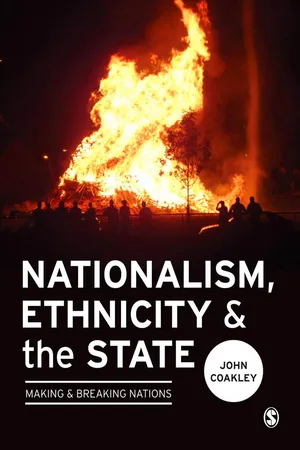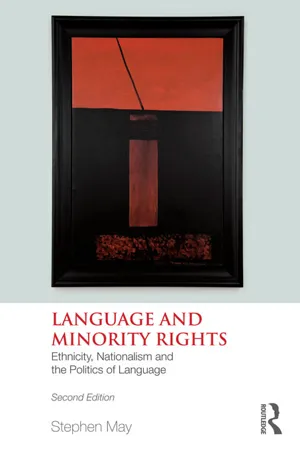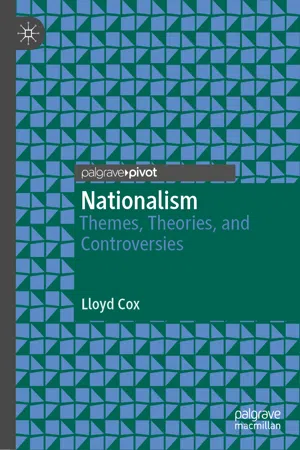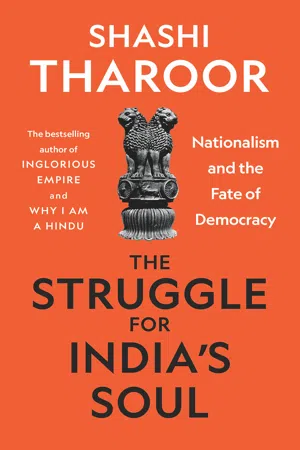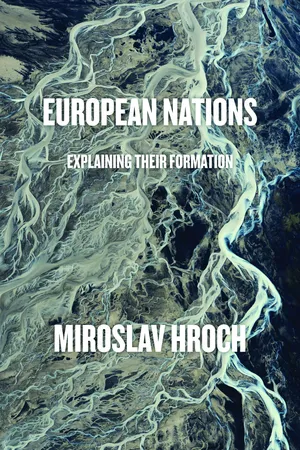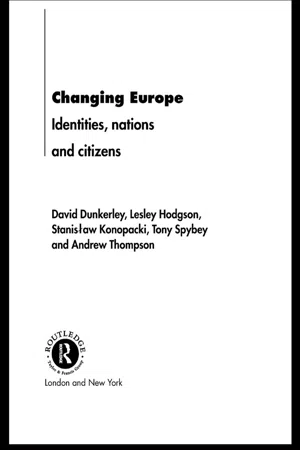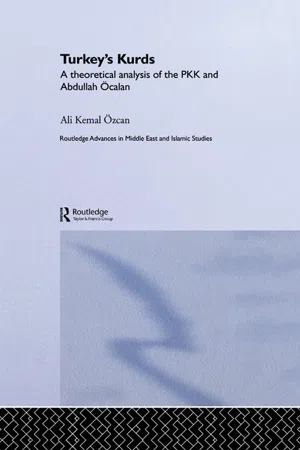History
Origin of Nationalism
The origin of nationalism can be traced back to the late 18th and early 19th centuries, when it emerged as a political and social movement. It was fueled by a sense of shared identity, culture, and history among a group of people within a specific geographical area. Nationalism played a significant role in shaping modern nation-states and continues to influence global politics and societies today.
Written by Perlego with AI-assistance
Related key terms
12 Key excerpts on "Origin of Nationalism"
- eBook - ePub
- Andrew Vincent(Author)
- 2023(Publication Date)
- Wiley-Blackwell(Publisher)
14Finally, some scholars have argued that nationalism is a product of the early nineteenth century. Hobsbawm, for example, claims that the modern usage of the term ‘nationalism’, as distinct from ‘ethnicity’, is in fact comparatively recent (Hobsbawm 1992 ). The modern idea probably only dates from the 1830s, although some aspects of its populist meaning were traceable to the American and French Revolutions. This latter point more or less coincides with the thrust of Gellner’s work, which also presents nationalism as a modern term corresponding to the growth and modernization of states in the nineteenth century (Gellner 1983 ). My own sympathies lie with those scholars who see nationalism as a distinctly modern movement emanating from the French Revolutionary era. This does not deny that there were earlier forms of group loyalty and allegiance. However, they were not nationalist in the context of nineteenth‐ and twentieth‐century understandings.Many of the above accounts identify phases of nationalist development. One of the more popular theories, which is widely quoted in the recent literature, is by Miroslav Hroch. He sees three distinct phases. First, nationalism is embodied in nineteenth‐century folklore, custom, and the like. This is essentially a cultural idea, fostered by the middle and upper classes, with little or no political implication. Second, nationalism is pursued as a political campaign. It is usually connected with and fostered by political parties. Finally, nationalism becomes translated into mass support and mass movements. Each of these phases is linked by Hroch to economic and cultural changes (Hroch 1985 ). Hobsbawm also identifies three phases or periods: initially 1830–80, which is dominated by liberal nationalism; then 1880–1914, which sees a sharp movement to the conservative right in nationalist thinking; and, finally, the apogee of nationalism is identified with the period 1918–50 (see Hobsbawm 1992 - eBook - ePub
Ethnicity and Nationalism
Anthropological Perspectives
- Thomas Hylland Eriksen(Author)
- 2010(Publication Date)
- Pluto Press(Publisher)
An emphasis on the duality of meaning and politics, common in ethnicity studies as well as research on nationalism, can also be related to anthropological theory on ritual symbols. In his work on the Ndembu, Victor Turner (1967, 1969) has showed that these symbols are multivocal and that they have an ‘instrumental’ and a ‘sensory’ (or meaningful) pole. In a remarkably parallel way, Anderson argues that nationalism derives its force from its combination of political legitimation and emotional power. Abner Cohen (1974b) has argued along similar lines when he states that politics cannot be purely instrumental, but must always involve symbols which have the power of creating loyalty and a feeling of belonging. More recently, studies of national flags (Eriksen and Jenkins, 2007) show how these symbols of nationality can both divide populations (if substantial numbers feel no loyalty towards the state and see the flag as a symbol of oppression) and unite them, precisely by being multivocal symbols that are amenable to different interpretations, thereby giving people who otherwise see each other as different a sense of unity.Anthropologists who have written about nationalism have generally seen it as a variant of ethnicity. I shall also do this at the outset; later on, however, I shall raise the question of whether non-ethnic nationalisms are imaginable.THE NATION AS A CULTURAL COMMUNITYBoth Gellner and Anderson emphasise that although nations tend to imagine themselves as old, they are modern. Nationalist ideology was first developed in Europe and in European diaspora (particularly in the New World; see Anderson, 1991 [1983]; Handler and Segal, 1992) in the period around the French Revolution. Here we must distinguish between tradition and traditionalism. Nationalism, which is frequently a traditionalistic ideology, may glorify and re-codify an ostensibly ancient tradition shared by the ancestors of the members of the nation, but it does not thereby re-create that tradition. It reifies it in the same way that the Hurons reified their supposed tradition (see chapter 4).Since nationalism is a modern phenomenon which has unfolded in the full light of recorded history, the ‘ethnogenesis’ of nations lends itself more easily to investigation than the history of non-modern peoples. Thus, the creation of Norwegian national identity took place throughout the nineteenth century, which was a period of modernisation and urbanisation. The country peacefully moved to full independence, leaving the union with Sweden, in 1905. - eBook - ePub
- Kathleen Braden, F.M. Shelley(Authors)
- 2014(Publication Date)
- Routledge(Publisher)
Nationality is a rather vague expression of group identity, perhaps at the largest level after family, clan, or tribe. The concept of nationality was born out of the European nation-state system, which emerged in the late Middle Ages. Yet in other parts of the globe, identity of group, rooted in part on location, has also been evident in tribal areas or units as large as empires. Great “nations” of people as far back as Biblical times have made their appearances and disappearances on the world map. For example, the Khazars were a nation of Turkic people whose empire lasted several hundred years in Eurasia; yet today, no one identifies him- or herself as Khazarian, and the language and culture have disappeared from the world.While the idea of “nations” has existed for millennia, the modern concept of “nationalism” only dates back several hundred years, and may already be outmoded. Nationalism has become a troubling concept in the post Cold War world. Division of much of the globe into easily identified blocks of East versus West made geopolitics a more clear-cut discipline than a more chaotic world wherein nationalist fervor has been reborn in many regions. Harm De Blij (1992) has noted: “the world of the twenty-first century is burdened with a boundary framework that is rooted in the 1800s, and with political systems few of which can accommodate the stresses of resurgent nationalisms and regionalisms”.Plate 5.1 Women in Samarkand, Uzbekistan (photo: Kathleen BradenTwo counter trends seem to be emerging at the end of the Cold War. On one hand, national identities that had often been submerged in constructed countries (such as the USSR and Yugoslavia) are now calling out again in force and resulting in conflict areas on the world stage. On the other hand, supranationalism, or the tendency to form alliances and political groups larger than national identities, continues and perhaps strengthens. This latter process may be the end of a trend that has been occurring in some global areas for many centuries. Westphalian identity has given way to German, which may be giving way to “European”. But some suggest that supranationalism exists mainly in political or economic terms, not psychological definition. Symbols of national identity, such as language, flags or food, could not be superseded by pan-European symbols, despite the selection of a flag and anthem for the Union. - eBook - ePub
Nationalism, Ethnicity and the State
Making and Breaking Nations
- John Coakley(Author)
- 2012(Publication Date)
- SAGE Publications Ltd(Publisher)
But nationalism is far from being a static phenomenon, and its dynamic character is explored in Part 2 of the book, which looks at nationalism as a process. The first sparks in a nationalist revolution are frequently ignited not by cultural renewal (as expressed, for example, in recognition that a particular language community shares a distinctive cultural heritage) but by socioeconomic grievance (such as a perception that one’s community – perhaps defined in relation to language – suffers discrimination of a more material kind). The relationship between nationalism and other universal sources of division (such as class and region) that do not of themselves carry any particular nationalist implications is discussed in Chapter 7. This chapter considers in particular not just the overt consequences of these phenomena for nationalism, but also the consequences of socioeconomic dislocation and political displacement in the context of rapid social change. Chapter 8 draws together more systematically the threads already discussed, looking at the manner in which nationalist movements have conventionally been organized. Here the organizing principle mixes historical with thematic criteria: an effort is made to generalize about the broad span of nationalist movements, from those driving to unify territories in the name of the national principle to those seeking independence in its name, or pursuing other agendas. This generalization builds on material presented in the earlier chapters, and charts a range of different pathways associated with the nationalist process. Chapter 9 addresses what is in many ways the most demanding and the most difficult question of all: how do nationalist movements arise, and what sustains them? A large literature has been generated in this area, and this chapter seeks to explore the main lines of argument - eBook - ePub
Language and Minority Rights
Ethnicity, Nationalism and the Politics of Language
- Stephen May(Author)
- 2013(Publication Date)
- Routledge(Publisher)
In so doing, an ethno-symbolic approach also allows us to untangle the confluence of the historical-cultural and legal-political dimensions of nationhood as they have come to be represented in the institutionalized form of the nation-state. As I have already suggested, this has arisen from the central principle of political nationalism – nation-state congruence – which holds that the boundaries of political and national identity should coincide. The view here is that people who are citizens of a particular state should also, ideally, be members of the same national collectivity. Gellner's definition of nationalism as a ‘theory of political legitimacy which requires that ethnic boundaries should not cut across political ones’ (1983: 1) clearly illustrates this standpoint. The end result of nationalism, in this view, is the establishment of the ethnically exclusive and culturally homogeneous nation-state.This attempt to make both state and national culture coextensive entities has resulted in the nation-state system as we know it today and continues to form the basis of many of the current nationalist claims for self-determination. And yet, interestingly, the earliest uses of the term ‘nationalism’ did not actually conflate the nation and the state in this way (Connor, 1978). However, by the nineteenth century nationalist doctrine had come to hold that nation and state were coterminous; that every nation deserved a state. Not only this, an important corollary had also by then emerged – that each state should represent one nation. As Gellner describes it, nationalism holds that the nation and state ‘were destined for each other; that either without the other is incomplete, and constitutes a tragedy’ (1983: 6). Max Weber would appear to concur in his observation that ‘a nation is a community which normally tends to produce a state of its own’ (1961: 176). This crucial interlinking of the idea of nation and its political representation in the state is perhaps not too surprising. As Immanuel Wallerstein observes:Why should the establishment of any particular sovereign state within the interstate system create a corresponding ‘nation’, a ‘people’? This is not really difficult to understand. The evidence is all around us. States in this system have problems of cohesion. Once recognised as sovereign, the states frequently find themselves subsequently threatened by both internal disintegration and external aggression. To the extent that ‘national’ sentiment develops, these threats are lessened. The governments in power have an interest in promoting this sentiment, as do all sorts of subgroups within the state … States furthermore have an interest in administrative uniformity that increases the efficacy of their policies. Nationalism is the expression, the promoter and the consequence of such state-level uniformities. (1991: 81–2) - Available until 20 Sep |Learn more
Territories
The Claiming of Space
- David Storey(Author)
- 2012(Publication Date)
- Routledge(Publisher)
There is a tendency to think of nations as fixed, static entities which have always existed. For most people it is taken for granted that we are born into a national group which has a historic attachment to a particular territory. However, this is somewhat simplistic. How did this national group come into existence? How and why did people come to perceive themselves as part of a collectivity of this nature? The existence of nations is not as straightforward as it might at first appear and there are a variety of theories concerning the origins of nations. For purposes of clarity, these can be subsumed within two main strands of thinking. The first are referred to as primordialist or essentialist theories. The second are modernist or functionalist theories. It is important to bear in mind that the inevitable reduction of quite complex arguments into broad categories results in over-simplification. However, this should still present a flavour of the nature of the debate over nations and nationalism.Primordialist TheoriesPrimordialists see nations (as distinct from the more recent phenomenon of nationalism) as having quite deep-seated historical origins. Strict primordialists would argue that nations have always existed. This essentialist way of thinking sees nations as natural entities whose origins go back to time immemorial. Nations are seen as possessing some historical and immutable core. From this perspective, there is seen to be something which is essentially Dutch, or German, or Serb. These ethno-national identities might be seen as an extension of kinship which, in socio-biological terms, is seen as the ‘natural’ social unit. An alternative approach is that language, religion, race, ethnicity and territory (components in the nationalist mix) are basic organizing principles. Viewed in either terms, nations are seen as naturally occurring human phenomena. This extreme primordialist approach is reflected in the idea of a ‘pure’ race or nation. As an example, the words of an Irish folk song reflect a belief in something immutable at the core of the nation ‘once upon a time there were Irish ways and Irish laws, villages of Irish blood waking to the morning’. Successive invasions of Ireland, first by the Vikings and then by the English, resulted in massacres and dispossession, yet ‘800 years we have been down, the secret of the water sound has kept the spirit of a man above the pain descending’1 - eBook - ePub
Nationality in History and Politics
A Psychology and Sociology of National Sentiment and Nationalism
- Frederick Hertz(Author)
- 2022(Publication Date)
- Routledge(Publisher)
Modern nationalism exhibits a puzzling combination of irrational and rational elements, and its very strength reposes in the union of mental primitiveness with all the instruments offered by the progress of science and technique. In all national movements the leading role was played by the intellectual classes, by professors, students, lawyers, officials, doctors, teachers, writers and journalists and sections of them also were the moving power in aggressive nationalism while the uneducated masses were tools in their hands. In spite of the intellectual character of the leading elite its doctrines as a rule denounced reason and exalted emotions and instincts. Yet nationalism cannot merely be the outcome of instincts since in this case it would be equally strong at all times and in all members of the species. There must be social factors which account for its variations according to time, nation and class. Many writers see in nationalism a survival of primeval barbarism while others explain it as the product of modern society, surfeited with intellectualism and disgusted with its results.A typical representative of the survival-school is H. Hankins, who in a scholarly book defines nationalism as self-assertion of that redoubtable being “the cave-man within us”.1 In his view the mentality of nationalism has developed in response to the conditions of an early time and has been preserved in the “communal mind” which exists “independently of the individual mind”, and “outside the nervous system and body of the individual The author attempts to substantiate this thesis by parellels taken from the customs and habits of primitive tribes and the behaviour of animals. A representative of the other school is Caroline Playne, who in several important books2 has interpreted nationalism and the war-spirit as “a social neurosis caused by the stress and strain of modern life The explanation of the primitive, fanatical tendencies of to-day as a return to barbarism, an atavistic upheaval, appears to her far too simple. The neurosis from which war springs is due to “the wear and tear to men’s nervous make-up caused by the increased pressure, complication and the fullness of life generally”, This thesis is elaborated in detail by an analysis of the psychological effects of social changes. Karl Mannheim in a profound study of modern mass-society has traced the growth of aggressiveness to social disintegration.11 Cf. E. Hanbury Hankins, Nationalism and the Communal Mind, 1937, pp. 151; 183, 187, 193.2 Caroline E. Playne, The Neuroses of the Nations, the Neuroses of Germany and France before the War, 1925; The Pre-War Mind in Britain, 1928; Society at War, 1930.1 Cf. Karl Mannheim, Man and Society in an Age of Reconstruction - eBook - ePub
Nationalism
Themes, Theories, and Controversies
- Lloyd Cox(Author)
- 2020(Publication Date)
- Palgrave Macmillan(Publisher)
European state and inter-state system. Although not reducing nationalism to state formation, they insist that nationalism can only be understood in relation to the modern state. Economic and cultural accounts, they suggest, are insensitive to the specificity of nationalism, because they neglect the centrality of politics.Michael Mann’s analysis of the rise of nationalism has two key parts: the first concerns the causes of European state formation; the second concerns the link between state formation, the multi-state system and nationalism. With respect to the first part, Mann emphasizes the politically and territorially fragmented character of European medieval society, which had a propensity to generate the political rivalry and warfare that was at the heart of state centralization. He argues that the necessity of improving military capabilities vis-à-vis enemies caused the costs of waging war to increase over time, providing the impetus for states to extract greater fiscal and manpower resources from the territories over which they ruled. The extent to which they were successful in extracting resources provides an explanation for, and an index of, their growth and consolidation into larger territorial units with greater infrastructural power and penetration. This first part of Mann’s argument is closely tied to the second part, which is focused on nationalism and is thus more central for our purposes.Mann argues that nationalism is ‘an ideology which asserts the moral, cultural and political primacy of an ethnic group (real or constructed),’ which, ‘allows for two main sub-types of nationalism, cultural and political …’ (1992 : 137). The origins and substance of this ideology can only be understood in the context of the emergence of the nation, which Mann defines as, ‘an extensive cross-class community affirming its distinct ethnic identity and history and claiming a state of its own’ (1993 : 215). Nations first emerged in late eighteenth-century Europe and America, though Mann concedes some ‘pre-modern - eBook - ePub
The Struggle for India's Soul
Nationalism and the Fate of Democracy
- Shashi Tharoor(Author)
- 2021(Publication Date)
- Hurst Publishers(Publisher)
In my years at the UN dealing with the civil war in the former Yugoslavia, I was struck by how often my interlocutors on all sides referred to events from the distant past: there were two Battles of Kosovo, in 1389 and 1448, but Serbs spoke of them as if they had happened yesterday, and that they justified their resentments today, and their belligerence tomorrow. To take an example closer to home, when V. D. Savarkar (later the father of “Hindutva”) was, in his youthful phase, an advocate for Hindu-Muslim unity, he declared the rebellion of 1857 to have been “India’s First War of Independence”, featuring as it did Indians across divides of religion, region, caste, and language, fighting under the flag of the Mughal sovereign. The appeal to a positive historical memory can play a significant role in constructing the nationalism of the present.That timeless national community so constructed is linked to a specific territory, resulting in a certain sanctification of geography, in the worship of the “motherland” as the natural home of the nation. Next, this sanctified geography is married to a holy history. The 19th century Italian nationalist Giuseppe Mazzini, who sought to unify the peninsula’s many warring principalities that had never served a common state, regarded patriotism as a duty, and love for the Fatherland as a divine mission, saying that the Fatherland was “the home wherein God has placed us, among brothers and sisters linked to us by the family ties of a common religion, history, and language.” The history of a nation is marked by a shared recollection of the nation’s victories and defeats in asserting itself as a national community—as well as, quite often, resentment and rejection of other nations or communities, especially foreign powers that have conquered or dominated them. In the process nationalism involves an act of purification: “purifying the people themselves”, in Anthony Smith’s words, “forging the “new man” and the ‘new woman,’ in the image of a pristine ideal found only in an idealized past of heroic splendour.”4“The past is an essential element, perhaps the essential element in [nationalistic] ideologies,” Eric Hobsbawm has argued. “If there is no suitable past, it can always be invented. The past legitimizes. The past gives a more glorious background to a present that does not have much to show for itself”.5 Hobsbawm compares the role of history to nationalism with that of the poppy to the heroin addict. Since the project of national unity which is indispensable to the expression of nationalism requires both a shared sense of cohesion, ethnicity or brotherhood, and an identifiable, secure, recognized territory, all nationalisms seek both such fraternity, and such a homeland. At the same time, to justify nationalistic zeal, both are required to be constructed on a long history—real or imagined—of collective experience. This is what makes history so important to the very idea of nationalism and so crucial to nation-building. The construction or even invention of history is, in Smith’s words, “no longer a scholarly pastime; it is a matter of national honour and collective endeavour”.6 - eBook - ePub
European Nations
Explaining Their Formation
- Miroslav Hroch, Karolina Graham, Karolina Graham(Authors)
- 2015(Publication Date)
- Verso(Publisher)
64 If we read his book carefully, we cannot overlook that he also advanced a list of social and cultural preconditions that had helped create nations over the centuries since at least the Reformation, independently of the wishes of ‘nationalists’ who followed later. Both examples illustrate the importance of not being content with superficially adopting attractive phrases when studying the ‘theories on nationalism’, and the need always to examine the research techniques and findings that lie behind these phrases.From the point of view of research methods, we can detect a certain polarity related to theories and empiricism, which to an extent corresponds with the specificity of different fields of study. At one end of the spectrum, there are empirical studies that, upon thorough examination, reveal the characteristic aspects of one particular or individual case of nation-forming. The conclusions they draw on this basis are relatively straightforward. The other end of the spectrum is occupied by sophisticated theoretical works, which are primarily concerned with the internal logic of the model. Most research projects can be found somewhere between the two extremes, and are divided into a number of categories according to how much theory or empiricism is contained in their analysis. Some authors, such as Deutsch and Gellner, work with a high level of abstraction and form generalised conclusions, which they assume will help explain individual cases. The next group of authors, including Hobsbawm and Smith, employ the ‘illustrative method’, form generalised observations, and prove – or rather, illustrate – their validity on more or less systematically selected examples. Other authors, such as Hechter and Nairn, analyse developments in one country and use their findings to draw generalised conclusions so as to prove or disprove various ‘theories’. The present volume comes closest to the works of authors such as Breuilly, who base theirs on a comparative study of a larger number of cases – nations – and form generalised conclusions from their findings. - eBook - ePub
Changing Europe
Identities, Nations and Citizens
- David Dunkerley, Lesley Hodgson, Stanislaw Konopacki, Tony Spybey, Andrew Thompson(Authors)
- 2003(Publication Date)
- Routledge(Publisher)
The situation in the Balkans indicates that the ideal of the nation-state is one which many groups still consider to be worth fighting for. Elsewhere, numerous movements seek independent nation-states, while national governments continue to speak on behalf of ‘the nation’. Thus the idea of the nation-state arguably remains as appealing as it was two centuries ago. It is nevertheless becoming more difficult now for states to pursue the ideal of the cultural nation as they once did. In western Europe governments have increasingly promoted a civic version of the nation-state, in which citizens hold multiple identities; identifying, for example, with their ethnic group, their nation and/or with the wider polity of which they are citizens. This version of the nation-state has become a necessity in countries that have experienced considerable immigration, as well as perhaps increased demands for autonomy from ethnic and national minorities. In these cases governments have had to search for new ways of maintaining the unity of the nation-state. As we will see, however, in other countries the state has become firmly aligned with one ethnic group. For us, the important questions are whether we will see a movement away from the ethnic nation-state in Europe, and, if so, how will ‘the nation’ be defined in this context? Before considering the current and future prospects of the idea of the nation-state, we must understand the routes this idea has taken.The rise and transformation of the nation-state: 1700s to 1945Searching for the origins of the nation-state is something of a red herring; since pure nation-states do not exist, as noted above, it is not possible to identify when they came into being. As we have said, however, the idea of the nation-state has been enormously powerful in European political history, as governments and political movements have sought to convert the theory into practice. What we need to consider, then, is the nation-state as a process, rather than as an entity. We will therefore focus on three processes: the development of the national territory; the transformation of the state; and the building of popular identification with nation and state.Dimensions of change
With regard to territory there are two points we should make. The first is that it is broadly acknowledged that the significance of national frontiers has developed gradually, since the 1648 Treaty of Westphalia. This Treaty ended the Thirty Years’ Wars that had raged across much of Europe. Among the consequences of the Treaty, arguably the most significant was that it established the principle of sovereignty, thus recognising that sovereigns were the sole source of power within their territory and the representative of that territory in foreign affairs.The second point is that since this period the state has come to increasingly occupy the entire national territory. Until the late eighteenth century, and more particularly the latter part of the nineteenth century, the state made little impact on the mass of the population throughout the national territory. Navari (1981) argues that until the French Revolution monarchs made little attempt to effect centralisation throughout their realm. Indeed, she suggests, if they had it is very likely that various interested parties would have resisted such moves. Significant changes began to happen from the late eighteenth century onwards. The cumulative effect of change in post-Westphalian Europe was that the state increasingly came to occupy and, indeed, create - eBook - ePub
- Ali Kemal Özcan(Author)
- 2012(Publication Date)
- Routledge(Publisher)
The Sociology of Nationalism, summarizes part of the problem by, first, alluding to the suggestive coupling statements by writers such as R. Miles, W. Connor, S. Bruce, L. Greenfeld and S. Hall. Of these, Connor – when justifying why he did not simply call his collection of essays ‘nationalism’ but ‘ethnonationalism’ – claims that ‘there is no difference if nationalism is used in its pristine sense’ (McCrone 1998: 22). Bruce draws lessons from the case of ‘Scottish nationalism’ by deducing that ‘it is precisely the lack of a single identity of a “people” with common ancestors, common language, shared religion and a glorious history which prevented nationalism emerging in Scotland when it was doing so in the twentieth century’ (ibid.: 22–23). Likewise, Greenfeld also couples ethnicity with nationalism, and says that‘nationality’ became a synonym of ‘ethnicity’, and national identity is often perceived as a reflection or awareness of possession of ‘prim-ordial’ or inherited characteristics, components of ‘ethnicity’, such as language, customs, territorial affiliation, and physical type.(Cited by McCrone 1998: 23)According to McCrone’s interpretation, Miles more radically argues that ‘“nations” have no independent existence outwith the discourse of nationalism’ – just as in the pairing of race and racism (ibid.: 25). In Anthony D. Smith’s work National Identity, this identity is defined and distinguished from the principal set of other identities by basing it on the ethnic entity of social man (Smith 1991: 19–42). Smith, however, devotes the larger share of the book to studying nation and nationalism, for he, too, inter-weaves the twin phenomena with the ethnic catalyst. In fact, the term ‘ethnicity’, McCrone reminds us, has been referred to as a social scientific concept ‘only in the mid-twentieth century’, and made its ‘official appearance in the Oxford English Dictionary
Index pages curate the most relevant extracts from our library of academic textbooks. They’ve been created using an in-house natural language model (NLM), each adding context and meaning to key research topics.
